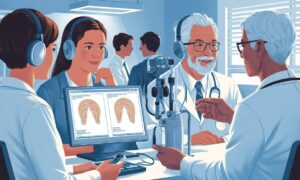When did you last glance at your smartwatch or Fitbit for health stats? A decade ago, such technology was exclusive to hospitals or medical facilities. Now, thanks to technological advancements, we can monitor our sleep, nutrition, and fitness with ease, right at our fingertips, empowering us to enhance our lifestyles.
In the same way a visit to your local doctor is more likely to lead to one or more high tech procedures from ultrasounds, to MRIs or one of the wide varieties of medical imaging tests.
But what happens when a patient suffers a medical incident or emergency during one of these tests? Well, this is where qualified first aid skills are a critical complement to the amazing expertise of the health tech professional..
In this article we’ll take a look at just some of the occasions where being a trained first aider is the best patient care that anyone can give as well as some exciting tech developments in first aid.
Health Tech Defined
Healthcare technology, or health tech, encompasses IT tools, software and diagnostic equipment designed to boost hospital efficiency, offer new insights into treatments, and elevate care quality. As organizations grow, health tech optimizes workflows and automates tasks beyond human capacity.
This tech supports healthcare professionals in improving patient care, enhancing experiences, and reducing burnout. QLD first aid course recognizes the significance of evolving technology and offers training for real-world emergencies, ensuring you stay updated.
Patient Safety in Health Tech: Why It’s More Crucial Than Ever
While we all rightly marvel at the rapid advancements in health tech, there’s an age-old skill that remains as crucial as ever: first aid. Imagine being at the forefront of medical technology, but when a patient faces an immediate crisis, you’re unsure of what to do.
This is especially true in smaller clinics or remote locations where access to other emergency care professionals may not be immediate. In all such cases, it is essential that a trained first aid responder steps in, ensuring that amidst all the tech, the human touch remains intact to save lives.
Handling Medical Equipment: The Intersection of Tech and First Aid
Medical equipment has evolved rapidly, becoming more sophisticated and specialized. Devices like AEDs and epipens are now commonplace in many settings. But with this advancement comes the need for specialized knowledge.
Comprehensive first aid training doesn’t just teach you how to bandage a wound; it equips professionals with the skills to operate these devices safely. Moreover, understanding the underlying principles of these devices, from the science of defibrillation to the biology of allergic reactions, can make the difference between good and bad medical outcomes.
Response to Allergic Reactions: Quick Thinking in Critical Moments
The world of health tech often involves introducing foreign substances or devices into the body, whether it’s a new drug, a contrast agent for imaging, or a novel implant. This increases the risk of allergic reactions. While most reactions might be mild, anaphylaxis, a severe and potentially life-threatening reaction, can occur.
First aid training prepares health tech professionals to recognize the signs of an allergic reaction and act swiftly, administering treatments like epinephrine when necessary.
Tech’s Latest Love Affair: First Aid Innovations
With the rise of telemedicine and digital health records, first aid has entered the digital age. Health tech professionals can now access patient data, consult with specialists, or even guide first aid remotely using telemedicine platforms. This fusion of first aid and technology ensures that patients receive optimum care, even in remote or underserved areas.
When Algorithms Meet Emergency: The Future is Here
Computational Intelligence (CI) is revolutionizing urgent care. Imagine a digital assistant guiding you through CPR or helping halt bleeding. With state-of-the-art algorithms, CI evaluates situations and offers real-time solutions. It’s like having a virtual first aid expert by your side, every step of the way.
Dive into Realism: Virtual Reality in First Aid Training
Virtual Reality (VR) isn’t just for gamers anymore. It’s shaping the future of first aid training. With a VR headset, you’re transported to lifelike emergency scenarios, allowing you to practice and perfect your skills in a controlled environment. It’s hands-on learning, with a tech twist.
First Aid Training: A Call to Action
While technology continues to revolutionize healthcare, the human touch remains irreplaceable.
It will always be true that when it comes to critical first aid, time is always of the essence. In most cases there is just not enough time to access a high tech CI first aid solution.
Consider the case where someone’s heart has stopped beating, necessitating cardiopulmonary resuscitation (CPR). Giving CPR keeps oxygenated blood pumping through the body ensuring it reaches the brain and vital organs. A person whose heart has stopped has an 80 percent chance of surviving if CPR is started in the first minute. Survival goes down to less than five per cent if CPR is not started within 10 minutes (Source: SBS News online).
Or what about care for patients who may suffer from asthma or allergies? More than two million Australians suffer from asthma and over four million from allergies (Source: SBS News online). These are both conditions that can lead to life-threatening situations requiring immediate first aid, especially in children.
For health tech professionals, first aid training complements their technical skills, ensuring they’re prepared for any situation. Whether you’re a seasoned professional or just starting in the field, consider enrolling in a first aid course. Organizations like First Aid Course Queensland offer comprehensive training tailored for the health tech sector.
Conclusion: First Aid in the Forefront of Health Tech
As the health tech sector continues to grow and evolve, the importance of first aid remains constant. It’s a reminder that while technology can enhance patient care, the fundamentals of first aid remain a cornerstone of healthcare. Whether you’re developing the next breakthrough medical device or implementing a new health IT system, remember the vital role of first aid in ensuring patient safety and well-being. Make every effort to ensure that you and your staff receive regular quality first aid training.



































